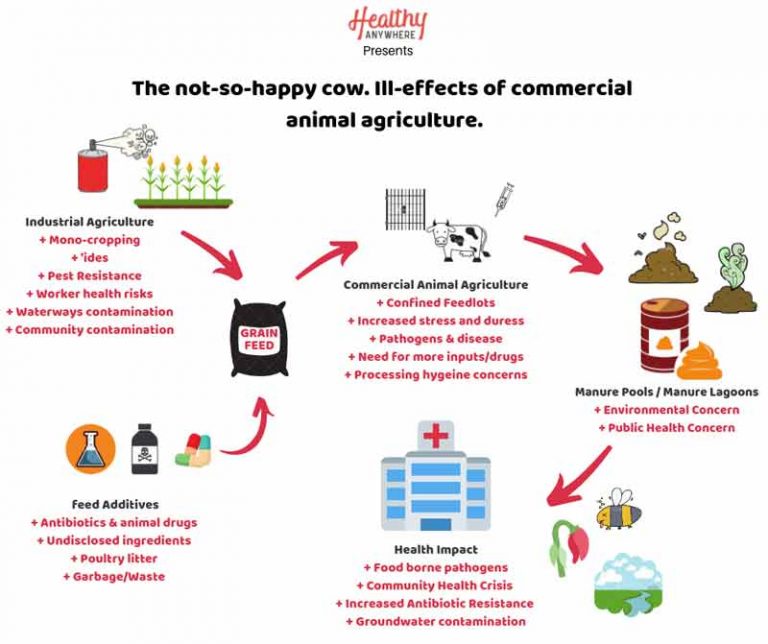A tale of the not-so-happy cow. Ill-effects from animal agriculture.
This topic is incredibly important and involved, with several distinct yet related vicious cycles – how to best communicate it all in a clear and non-confusing way? The burden of responsibility seems heavy, as it impacts our own wellbeing and that of our animals, our land, and ultimately – our planet.
A graphic seems prudent to visualize the components involved in Concentrated Animal Feedlot Operations (CAFO), the technical term for commercial feeding operations that confine over 1k pounds of animals for at least 45 days (usually longer) across a year.

What you can do:
REFERENCES
- American Veterinary Medical Association (AVMA). “Guidelines for Veterinary Prescription Drugs”. Retrieved at: https://www.avma.org/KB/Policies/Pages/Guidelines-for-Veterinary-Prescription-Drugs.aspx
- Gupta, PK.Illustrated Toxicology. (April, 2018) Academic Press. Chapter 15.
- World Health Organization (WHO). (Feb, 2018) “Antibiotic Resistance” Fact Sheet. Retrieved at: https://www.who.int/news-room/fact-sheets/detail/antibiotic-resistance
- Environmental Protection Agency (EPA). “PRN 97-6: Use of Term ‘Inert’ in the Label Ingredients Statement.” Retrieved At: https://www.epa.gov/pesticide-registration/prn-97-6-use-term-inert-label-ingredients-statement
- Bhaskara Reddy. M, Vijaya & Reddy, Yeddula. (2015). PESTICIDE RESIDUES IN ANIMAL FEED AND EFFECTS ON ANIMALS AND ITS PRODUCTS WITH SPECIAL REFERENCE TO ENDOSULFAN. International Journal of Research in Ayurveda & Pharmacy. 6. 371-374. 10.7897/2277-4343.06372.
- The Edible School Yard Project. (Jan 30, 2019). “Understanding our FoodPrint and The Power of Transparency, with Urvashi Rangan, Ph.D.” Retrieved at: https://www.youtube.com/watch?v=LLbVQ7bRvGk
- FoodPrint. “FoodPrint Issue: Antibiotic use in our food system”. Retrieved at: https://foodprint.org/issues/antibiotics-in-our-food-system/
- USGS. (1999) “Effects of Confined Animal Feeding Operations (CAFOs) on
Hydrologic Resources and the Environment”, “Concentrated Animal Feeding Operations (CAFOs” by Mary G. Henry. Retrieved at: https://water.usgs.gov/owq/AFO/proceedings/afo/html/henry.html
Healthy Anywhere connects travelers with delicious, organic and sustainable foods, and helps them maintain healthy habits, anywhere.
Eat Clean + Breathe Deep + Move Often = Never Settle


Pingback: The impossible logic of the Impossible Burger - Healthy Anywhere
Pingback: The best *real* plant-based burgers in restaurants right now - Healthy Anywhere